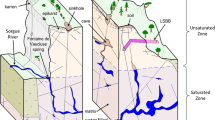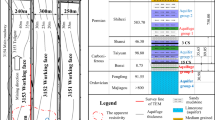Abstract
During the long-term stability assessment of underground disposal repositories buried in sedimentary formations, one of crucial scientific problems is to determine parameters of site formations. The analysis of response of the pore pressure due to atmospheric loading provides a possible way of accurate estimation of formation parameters. In this paper, an analytical solution of response of the pore pressure to atmospheric loading was derived starting from the Biot’s poroelasticity, and its corresponding numerical solutions were developed by finite element methods for 1D and 2D situations. With comparison to the analytical solution, the experimental results show that the numerical schemes sound reasonable to implement the assessment of response of the pore pressure in horizontal multilayer sedimentary formations. In particular, it is effective for a 2D model over large area with consideration of background horizontal groundwater flow. A highlight of this work is to construct a reasonable approach to capture responses of the pore pressure to atmospheric loading, and at the same time to provide the feasibility of integrated analysis of well monitoring data of pore pressure variance in Horonobe Underground Research Laboratory (URL), Hokkaido, Japan.







Similar content being viewed by others
References
ABAQUS Inc. (2008) ABAQUS theory manual, version 6.8. Dassault Systèmes, Providence
Alexander WR, McKinley L (2007) Deep geological disposal of radioactive waste. In: Baxter MS (ed) Radioactivity in the environment, 1st edn. Elsevier, Oxford, p 300
Biot MA (1941) General theory of three-dimensional consolidation. J Appl Phys 12:155–164
Brie A, Endo T, Johnson DL, Pampuri F (2000) Quantitative formation permeability evaluation from Stoneley waves. SPE Reserv Eval Eng 3:109–117. doi:10.2118/60905-pa
Cheng Y, Lee WJ, McVay DA (2009) A new approach for reliable estimation of hydraulic fracture properties using elliptical flow data in tight gas wells. SPE Reserv Eval Eng 12:254–262. doi:10.2118/105767-pa
El Shafei I, Zaki M, Andreani M (1989) Estimating formation permeability and producibility in oil-based mud using the EPT. Middle East Oil Show. SPE, Kingdom of Bahrain, pp 1–6
Evans K, Beavan J, Simpson D (1991) Estimating aquifer parameters from analysis of forced fluctuations in well level: An example from the nubian formation near Aswan, Egypt 1. Hydrogeological background and large-scale permeability estimates. J Geophys Res 96:12127–12137. doi:10.1029/91jb00955
Gok I, Onur M, Kuchuk FJ (2005) Estimating formation properties in heterogeneous reservoirs using 3D interval pressure transient test and geostatistical data. SPE Middle East Oil and Gas Show and Conference. SPE, Kingdom of Bahrain, pp 1–26
Hama K, Kunimaru T, Metcalfe R, Martin AJ (2007) The hydrogeochemistry of argillaceous rock formations at the Horonobe URL site, Japan. Phys Chem Earth 32:170–180
Hidajat I, Rastogi A, Singh M, Mohanty KK (2001) Transport properties of porous media from thin-sections. SPE Latin American and Caribbean Petroleum Engineering Conference. SPE, Buenos Aires, Argentina, pp 1–14
Hosoya S, Tokunaga T (2005) Estimation of specific storage and vertical hydraulic conductivity from depth-dependency of pore pressure responses to atmospheric loading. Jpn Assoc Groundw Hydrol 47:397–417
Hosoya S, Kunimaru T, Shibano K (2009) Evaluating the formation properties by the analyses of groundwater pressure data (contract research). JAEA Horonobe Underground Research Unit, Tokai-mura, p 86
James SC, Zimmerman DA (2003) Preliminary uncertainty and sensitivity analysis for basic transport parameters at the Horonobe site, Hokkaido, Japan. Sandia Report SAND2003-3156. Sandia National Laboratories, pp 1–30
Jat ML, Acharya MS, Singh J (1995) Estimation of aquifer parameters by least-squares method under linear flow conditions in fractured rocks. Nordic Hydrol 26:111–124
JNC (2004) International workshop on Horonobe underground research laboratory project: Record. Horonobe Underground Research Center, p 189
Lee WJ, Kuo TB, Holditch SA, McVay DA (1984) Estimating formation permeability from single-point flow data. SPE Unconventional Gas Recovery Symposium. SPE, Pittsburgh, Pennsylvania, pp 1–11
Li Q, Wu ZS, Lei X-L, Murakami Y, Satoh T (2007) Experimental and numerical study on the fracture of rocks during injection of CO2-saturated water. Environ Geol 51:1157–1164. doi:10.1007/s00254-006-0406-y
Li Q, Ito K, Tomishima Y, Seki Y (2009a) Bridging satellite monitoring and characterization of subsurface flow: with a case of Horonobe underground research laboratory. In: Oka F, Murakami A, Kimoto S (eds) Prediction and simulation methods for geohazard mitigation. CRC Press, New York, pp 519–524
Li Q, Ito K, Wu ZS, Lowry CS, Loheide SP II (2009b) COMSOL multiphysics: a novel approach to groundwater modeling. Ground Water 47:480–487. doi:10.1111/j.1745-6584.2009.00584.x
Nur A, Byerlee JD (1971) An exact effective stress law for elastic deformation of rock with fluids. J Geophys Res 76:6414–6419. doi:10.1029/JB076i026p06414
Pinder GF, Bredehoeft JD, Cooper HH Jr (1969) Determination of aquifer diffusivity from aquifer response to fluctuations in river stage. Water Resour Res 5:850–855. doi:10.1029/WR005i004p00850
Research Core for Deep Geological Environments (2010) Validation study on the groundwater flow model using comprehensive approaches (observation survey of Horonobe URL). Geological Survey of Japan, p 146
Rice JR, Cleary MP (1976) Some basic stress diffusion solutions for fluid-saturated elastic porous media with compressible constituents. Rev Geophys Space Phys 14:227–241
Rojstaczer S (1988) Determination of fluid flow properties from the response of water levels in wells to atmospheric loading. Water Resour Res 24:1927–1938. doi:10.1029/WR024i011p01927
Rojstaczer S, Agnew DC (1989) The influence of formation material properties on the response of water levels in wells to earth tides and atmospheric loading. J Geophys Res 94:12403–12411. doi:10.1029/JB094iB09p12403
Rojstaczer S, Riley FS (1990) Response of the water level in a well to earth tides and atmospheric loading under unconfined conditions. Water Resour Res 26:1803–1817
Russell DG (1963) Determination of formation characteristics from two-rate flow tests. SPE J Petrol Technol 15:1347–1355. doi:10.2118/645-pa
Saner S, Kissami M, Nufaili SA (1997) Estimation of permeability from well logs using resistivity and saturation data. SPE Form Eval 12:27–31. doi:10.2118/26277-pa
Satman A, Onur M, Tureyen OI (2000) New methods for determining formation properties from stabilized and unstabilized gas-well-test data. SPE/CERI Gas Technology Symposium. SPE, Calgary, Alberta, Canada, pp 1–15
Şen Z (1986) Aquifer test analysis in fractured rocks with linear flow pattern. Ground Water 24:72–78. doi:10.1111/j.1745-6584.1986.tb01461.x
Silin DB, Tsang C-F (2001) Estimation of formation hydraulic properties from analysis of regular operations data. SPE Western Regional Meeting. SPE, Bakersfield, California, pp 1–8
Tariq SM, Denoo S, Cordes M (1997) Permeability estimation from modern NMR logging measurements: Experiences and applications in the Rocky Mountain area. SPE Rocky Mountain Regional Meeting. SPE, Casper, Wyoming, pp 1–16
Urakoshi T, Hosoya S, Tokunaga T (2006) Applicable depth ranges for estimating hydraulic properties from periodic pore pressure fluctuations caused by surface loadings. J Geogr 115:279–294
Van Der Kamp G, Gale JE (1983) Theory of earth tide and barometric effects in porous formations with compressible grains. Water Resour Res 19:538–544. doi:10.1029/WR019i002p00538
Verruijt A (1977) Generation and dissipation of pore water pressures. In: Gudehus G (ed) Finite elements in geomechanics. Wiley, London, pp 293–317
Wackernagel H (1999) Multivariate geostatistics: an introduction with applications, 2nd revised edn. Springer, Berlin
Wang HF (2000) Theory of linear poroelasticity with applications to geomechanics and hydrogeology, 1st edn. Princeton University Press, Princeton
Wang K, Davis EE (1996) Theory for the propagation of tidally induced pore pressure variations in layered subseafloor formations. J Geophys Res 101:11483–11495. doi:10.1029/96jb00641
Yao CY, Holditch SA (1996) Reservoir permeability estimation from time-lapse log data. SPE Form Eval 11:69–74. doi:10.2118/25513-pa
Yildiz T (1998) Prediction of in situ formation compressibility from production data. SPE/ISRM Rock Mechanics in Petroleum Engineering. SPE, Trondheim, Norway, pp 1–8
Acknowledgments
This project is regulatory support research funded by the Nuclear and Industrial Safety Agency (NISA) of Japan. QL is partially supported by the Hundred Talent Program of Chinese Academy of Sciences. Prof. T. Tokunaga and Dr. M. Aichi (Graduate School of Frontier Sciences, University of Tokyo) were greatly acknowledged for their discussion on the construction of the analytical solution. Thanks are due to anonymous reviewers for a very careful review of the manuscript and the critical comments of improvements.
Author information
Authors and Affiliations
Corresponding author
Rights and permissions
About this article
Cite this article
Li, Q., Ito, K. Analytical and numerical solutions on the response of pore pressure to cyclic atmospheric loading: with application to Horonobe underground research laboratory, Japan. Environ Earth Sci 65, 1–10 (2012). https://doi.org/10.1007/s12665-011-1058-0
Received:
Accepted:
Published:
Issue Date:
DOI: https://doi.org/10.1007/s12665-011-1058-0




